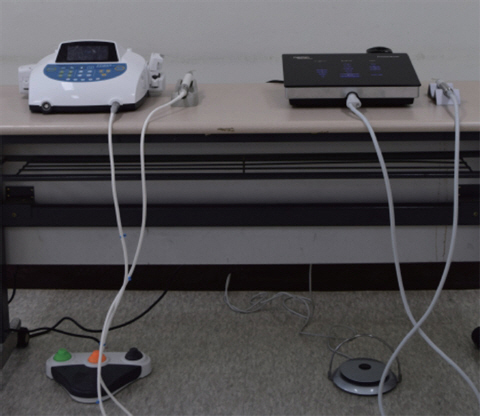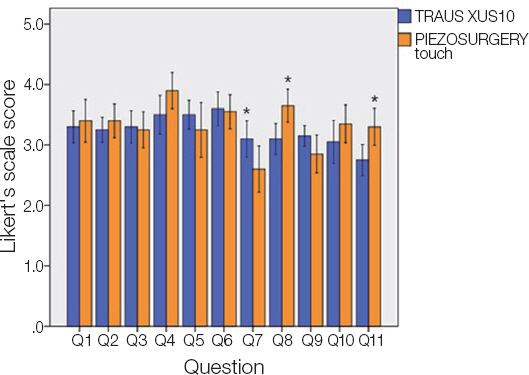J Dent Rehabil Appl Sci.
2017 Dec;33(4):269-277. 10.14368/jdras.2017.33.4.269.
A comparative study on the user satisfaction between two different piezoelectric engines
- Affiliations
-
- 1Department of Dentistry, Graduate School, Kyungpook National University, Daegu, Republic of Korea.
- 2Advanced Dental Device Development Institute, Kyungpook National University, Daegu, Republic of Korea.
- 3Department of Prosthodontics, School of Dentistry, Kyungpook National University, Daegu, Republic of Korea.
- 4Department of Oral & Maxillofacial Surgery, School of Dentistry, Kyungpook National University, Daegu, Republic of Korea. dentalchoi@knu.ac.kr
- KMID: 2405539
- DOI: http://doi.org/10.14368/jdras.2017.33.4.269
Abstract
- PURPOSE
The aim of this study is to compare the performance of two piezoelectric engine systems by surveying satisfaction from dental clinicians.
MATERIALS AND METHODS
Two piezoelectric systems were evaluated: TRAUS XUS10 (Saeshin), PIEZOSURGERY touch (Mectron). For this study, 20 dentists responded to the 11 questionnaires in which 5 point Likert-type scale was used. The two devices were operated for 10 seconds and measured 5 times to compare the maximum noise values. In heat emission test, the handpiece was operated for 3 minutes and heat was measured at three positions each.
RESULTS
TRAUS XUS10 had higher satisfaction level on motor noise (P < 0.05). About function key and handpiece heat generation, PIEZOSURGERY touch showed higher satisfaction (P < 0.05) than TRAUS XUS10. The maximum noise level for each of the devices was confirmed to be 56.6 dB for the TRAUS XUS10 and 56.0 dB for PIEZOSURGERY touch. The two piezoelectric engines satisfied the safety standards with an operation temperature below 41℃ after having been operated for 3 minutes.
CONCLUSION
Except for the function key and handpiece heat emission, TRAUS XUS10 has comparable performance with PIEZOSURGERY touch.
Figure
Reference
-
References
1. Stübinger S, Kuttenberger J, Filippi A, Sader R, Zeilhofer HF. Intraoral piezosurgery: preliminary results of a new technique. J Oral Maxillofac Surg. 2005; 63:1283–7. DOI: 10.1016/j.joms.2005.05.304. PMID: 16122591.2. Blus C, Szmukler-Moncler S, Salama M, Salama H, Garber D. Sinus bone grafting procedures using ultrasonic bone surgery:5-year experience. Int J Periodontics Restorative Dent. 2008; 28:221–9. PMID: 18605597.3. Robiony M, Polini F, Costa F, Vercellotti T, Politi M. Piezoelectric bone cutting in multipiece maxillary osteotomies. J Oral Maxillofac Surg. 2004; 62:75961. DOI: 10.1016/j.joms.2004.01.010.4. Ma L, Stübinger S, Liu XL, Schneider UA, Lang NP. Healing of osteotomy sites applying either piezosurgery or two conventional saw blades: a pilot study in rabbits. Int Orthop. 2013; 37:1597–603. DOI: 10.1007/s00264-013-1908-3. PMID: 23793460. PMCID: PMC3728383.5. Eggers G, Klein J, Blank J, Hassfeld S. Piezosurgery: an ultrasound device for cutting bone and its use and limitations in maxillofacial surgery. Br J Oral Maxillofac Surg. 2004; 42:451–3. DOI: 10.1016/j.bjoms.2004.04.006. PMID: 15336773.6. Labanca M, Azzola F, Vinci R, Rodella LF. Piezoelectric surgery: twenty years of use. Br J Oral Maxillofac Surg. 2008; 46:265–9. DOI: 10.1016/j.bjoms.2007.12.007. PMID: 18342999.7. Seshan H, Konuganti K, Zope S. Piezosurgery in periodontology and oral implantology. J Indian Soc Periodontol. 2009; 13:155–6. DOI: 10.4103/0972-124X.60229. PMID: 20379414. PMCID: PMC2848787.8. Vercellotti T, Dellepiane M, Mora R, Salami A. Piezoelectric bone surgery in otosclerosis. Acta Otolaryngol. 2007; 127:932–7. DOI: 10.1080/00016480601110154. PMID: 17712671.9. Jensen OT, Shulman LB, Block MS, Iacono VJ. Report of the Sinus Consensus Conference of 1996. Int J Oral Maxillofac Implants. 1998; 13(Suppl1):1–45. PMID: 9715571.10. Seshan H, Konuganti K, Zope S. Piezosurgery in periodontology and oral implantology. J Indian Soc Periodontol. 2009; 13:155–6. DOI: 10.4103/0972-124X.60229. PMID: 20379414. PMCID: PMC2848787.11. Lee DH, Lee KB. The comparative study of user satisfaction on various implant engine system. J Dent Rehabil Appl Sci. 2014; 30:9–15. DOI: 10.14368/jdras.2014.30.1.9.12. Pearce AI, Richards RG, Milz S, Schneider E, Pearce SG. Animal models for implant biomaterial research in bone: a review. Eur Cell Mater. 2007; 13:1–10. DOI: 10.22203/eCM.v013a01. PMID: 17334975.13. An YH, Freidman RJ. Animal models in orthopaedic research. Boca Raton;CRC Press;. 1998; 3957.14. Buser D, Schenk RK, Steinemann S, Fiorellini JP, Fox CH, Stich H. Influence of surface characteristics on bone integration of titanium implants. A histomorphometric study in miniature pigs. J Biomed Mater Res. 1991; 25:889–902. DOI: 10.1002/jbm.820250708. PMID: 1918105.15. Sun C, Huang G, Christensen FB, Dalstra M, Overgaard S, Bünger C. Mechanical and histological analysis of bone-pedicle screw interface in vivo: titanium versus stainless steel. Chin Med J (Engl). 1999; 112:456–60.16. Davies AR, Ware JE Jr. Measuring patient satisfaction with dental care. Soc Sci Med A. 1981; 15:75160. DOI: 10.1016/0271-7123(81)90019-5.17. IECEE. International Electrotechnical Commission. Available from: http://www.iec.ch/search/?q=Applied%20parts%20not%20intended%20to%20supply%20heat%20to%20a%20patient'. (updated 2017 Aug 14).18. Lee JH, Oh JM, Hong Y, Kim S, Paik J, Lee YJ, Lee JB, Lee SD. Design and evaluation of ultrasonic bone surgical instruments for dental application. J Korean Inst Electr Electron Mater Eng. 2012; 25:990–5. DOI: 10.4313/JKEM.2012.25.12.990.19. Kramer FJ, Bornitz M, Zahnert T, Schliephake H. Can piezoelectric ultrasound osteotomies result in serious noise trauma? Int J Oral Maxillofac Surg. 2015; 44:1355–61. DOI: 10.1016/j.ijom.2015.03.004. PMID: 26227860.20. Lehto TU, Laurikainen ET, Aitasalo KJ, Pietilä TJ, Helenius HY, Johansson R. Hearing of dentists in the long run: a 15-year follow-up study. Community Dent Oral Epidemiol. 1989; 17:207–11. DOI: 10.1111/j.1600-0528.1989.tb00613.x. PMID: 2758794.21. Ji DH, Choi MS. Characteristics of noise radiated at dental clinic. J Korean Soc Environ Eng. 2009; 31:1123–8.22. Lee JS, Han YS, Cho YS. The noise level assessment of dental equipment. J Dent Hyg Sci. 2015; 15:603–11. DOI: 10.17135/jdhs.2015.15.5.603.23. Walmsley AD. Potential hazards of the dental ultrasonic descaler. Ultrasound Med Biol. 1988; 14:15–20. DOI: 10.1016/0301-5629(88)90159-7.
- Full Text Links
- Actions
-
Cited
- CITED
-
- Close
- Share
- Similar articles
-
- Survey User Satisfaction in Aspect of User Interactions With an Order Communication System in Seoul National University Hospital
- User Satisfaction of Nursing Information System
- The Effect of Hospital SCM on Logistics Performance
- Effect of the ERP Quality on the Performance and Causal-Effect Analysis between Outcome Variables in the Contract Foodservice Management Company
- User's Satisfaction on the Electronic Medical Record System in Seoul National University Bundang Hospital





